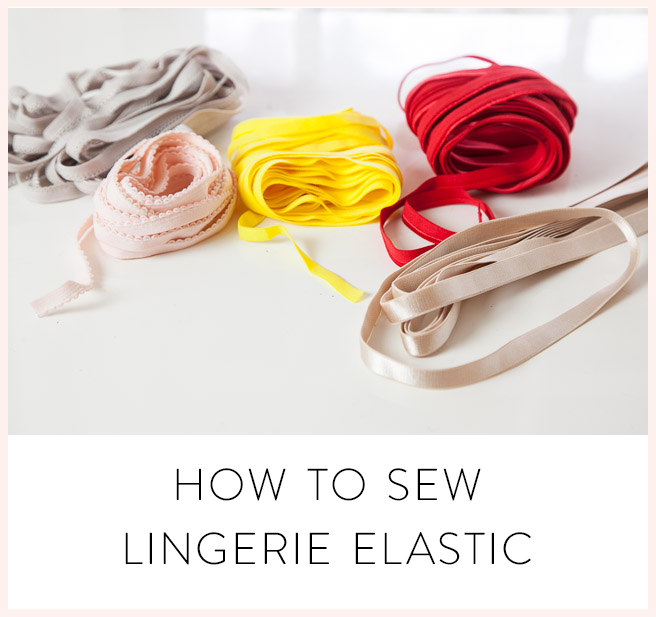
We’re almost ready to cut! Before we get to cutting or sewing, I thought it would be useful to review the basics in sewing lingerie elastic. It’s very simple but you’ll be doing it over and over again.
If you are brand new to sewing elastic, you don’t need any special equipment, just your regular zig-zag foot. To make things easier to understand for beginners, I included a short video at the end.
Basic Elastic Technique
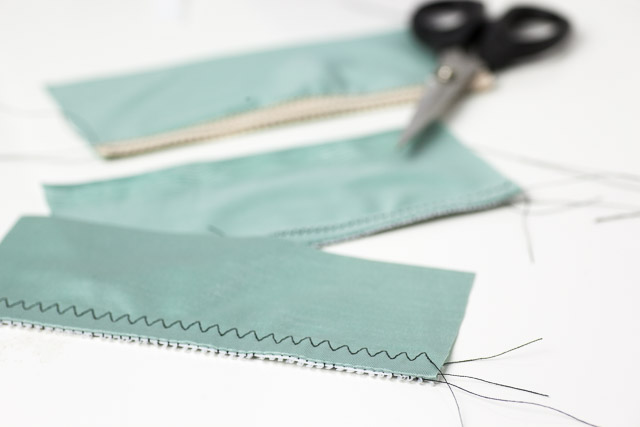
Except for the straps on the bra, all of the elastic is applied using the same “stitch, fold and stitch” method that is commonly used for lingerie elastic.
1. Align the non-decorative edge with the edge of the fabric. You want the wrong or plush side to be facing up.
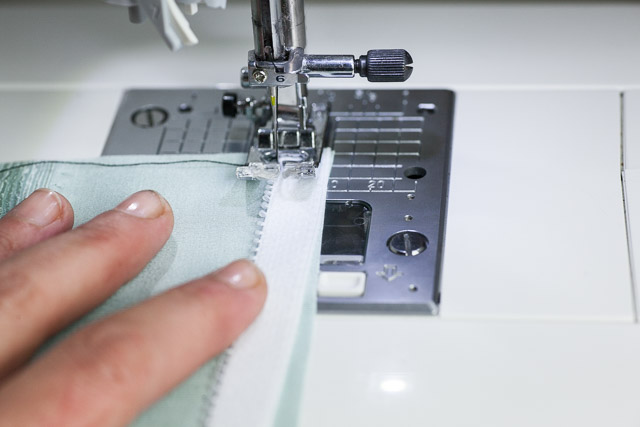
If your elastic does not have a plush backing, it might be harder to distinguish the wrong from right sides, in which case you can use whichever side you like better.
2. Stitch the elastic to the fabric, using a smaller zig-zag. As you are stitching pull the elastic gently (see tips at bottom for what I mean by gently).
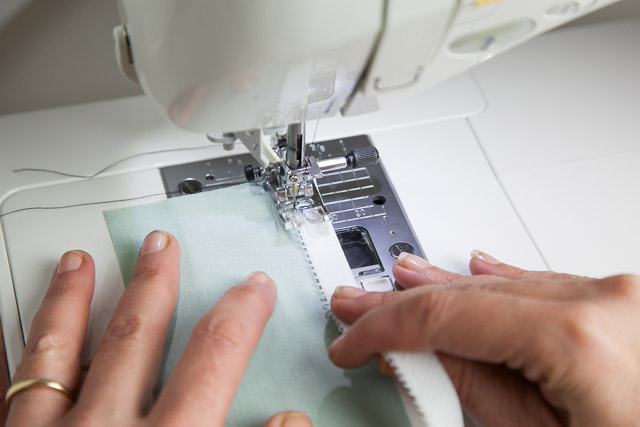
Try to get your zig-zags as close as possible to the decorative edge. It will almost look like your needle is going over the edge of the elastic.
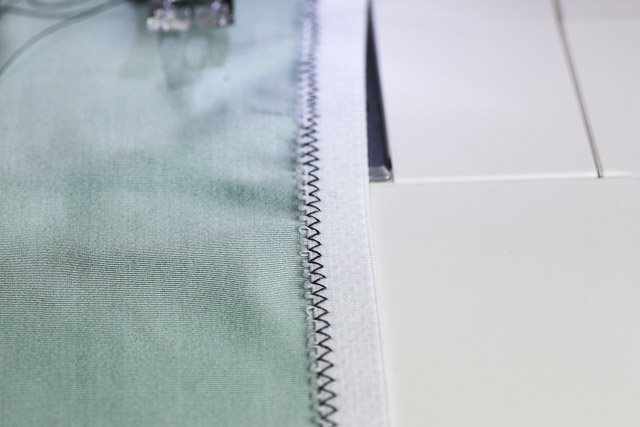
Don’t worry if you veer off a bit. It takes practice and you won’t notice these minor things in the end.
2. Once you are done, you can trim down the fabric close to the stitches. I don’t always trim. It depends on the weight of the fabric, how much bulk it might add, and whether or not it is peeking out from the elastic.
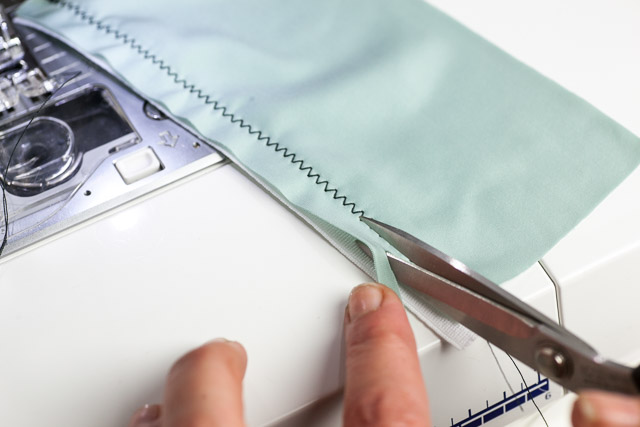
3. Turn your work around and fold the elastic over that the wrong side is facing up again, and stitch again getting as close to the edge as you can. On this second pass you usually want a slightly wider zig-zag, or a 3-step zig-zag for certain elastics.
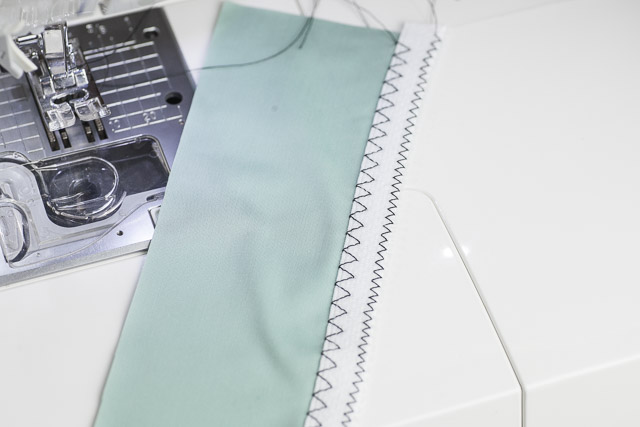
Stitch Lengths
The Watson instructions include suggested stitch lengths and widths for every step and I’ll be reiterating those when we sew.
As you gain more experience, you’ll learn that every elastic is different and sometimes you need to adapt your stitches to the elastic. Take a look at some of your favorite RTW undergarments and see what stitches are used and where and on what kind of elastic. Try to replicate these on scraps of fabric and see if you like them.
The Triple Zig-zag
This stitch is sometimes called a 3-step zig-zag. It does exactly that–takes 3 straight stitches up and 3 straight stitches down. You can see the difference between the 3-step and a regular zig-zag on the left:
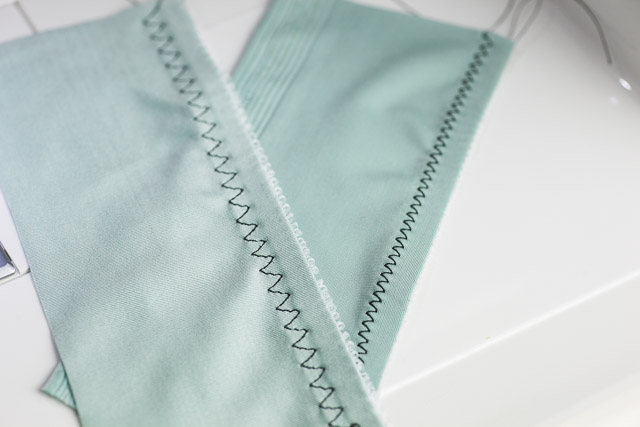
Most modern machines come with with a 3-step zig-zag, but if yours doesn’t don’t worry. I’ve made many bras and underwear without it, and never had a popped stitch on them. The best place to use this stitch is on a firm, plush elastic. It is often used and the top and bottom of bra bands, and very occasionally on underwear.
You don’t need to use it everywhere, and one reason has to do with preventing elastic fatigue. In manufacturing they do a lot of testing for the best elastic tension and stitch type for each elastic and how it interacts with the weight of the fabric. The more stitches and thread you put into an elastic, the more you impact its ability to rebound. A firmer plush elastic can handle the heavy stitching, but lightweight and very stretchy elastics will lose a lot of their rebound with a 3-step. This is the most frequent cause of wavy edges—when an elastic has stretched further than the actual length of the opening and is not able to rebound back to the original or smaller size.
In general, I recommend only using the triple zig-zag on elastics that are 3/8″ or wider, have a plush backing and are fairly firm.
How Much To Pull?
I like to sew in elastic by feel. In bra-making, this is a very good skill to develop.
If you have never tried this before, try this: cut a piece of your lingerie elastic exactly 5 3/4″ or 14.6cm. Stretch it out to 6″ or 15.2cm. This is what 5% reduction feels like, and is a good idea of how much to stretch on most elastics as you are sewing.
I don’t calculate this any of this ahead of time; it’s more intuitive and I promise you don’t have to think about it that much and soon enough you’ll get a feel for how much tension you like.
Most elastics work best with anywhere from 3-8% reduction. In other words, the length of the elastic is 3-8% less than the actual seam line it is covering. I’d say that 8% is on the extreme end. The harder you stretch on an elastic as you are stitching, the more thread you put into a smaller space in the elastic and reduce its ability to rebound and continue flexing with wear. For the hem on a bra band, I put very little tension on the elastic. (It probably works out to about 3% but I haven’t measured that.) For underwear and the lighter bra elastics I pull a little bit more.
Would you like tips and inspiration in the craft of lingerie sewing? Sign up for my weekly eletter The Lingerie Maker.

Thank you for the great Posts About lingerie-making.
Do you have a standaard zigzag and triplezigzag setting that you use on most fabrics? I know that the type of fabric and elastic matters but what is your startingpoint? Thank you !
Hi Willemijn, yes, as I mentioned the Watson pattern has specific stitches in the instructions and those are my personal starting points. I keep all my favorites on sticky notes on my sewing machine!.
This is such great info!
A very helpful post & video.. thank you!
Thank you for the great informative video and information, it will come in handy.
What great tips! The video at the end was particularly helpful.
So, I want to use a wider elastic on the bottom of the long line band, approximately 3/4″ or 1″ wide. Do you recommend extending the length of the band to accommodate the extra fabric I would be cutting off ?
Hi Grace, yes that’s right. I wrote about this in the bra adjustment post. This pattern has a 1/2” elastic allowance for the bottom hem. If you want to use a 3/4” elastic you’d add 1/4” to the bottom of the band. If you want to use 1″ you’d add 1/2″.
Thank you! Sorry I missed that detail in the adjustment post.
When you do the 2nd pass with the elastic folded over do you also gently pull?
Not really, since it is already stretched to length by the first pass of stitching. If you look at the video, starting about at around 1:15, you can see what I do with my hands. I just keep the elastic and fabric smoothly lined up as I am stitching.
How come sometimes after I sew one my elastic it doesnt want to lay flat? ( especially on the inside curve)
I also have the same problem and cannot find a solution anywhere. My edges do not want to lie flat, despite tension on the elastic when sewing. Very frustrating.
Hi Devin,
You may want to experiment with different tensions by sewing a scrap of elastic and fabric, and then no tension at all, to see what happens. I personally find that the less tension there is on the elastic, the less it wants to flip. When elastic is stretched in sewing, it is always going to find the path of least resistance to recover to its original length. So flipping up is just that. If it folds all the way onto itself, then I suspect the elastic is definitely being sewn in too tightly. But flipping up a tiny bit can be natural and even happens in ready-to-wear. This is just cosmetic; as long as it looks and feels good on you, that’s what matters!
I wish I’d looked at this two weeks ago, when I was making a camisole. the elastic on it turned out ok, but it for sure would have been neater if I’d read this first..oh well, I have my first watson bra to practice on!
Should you back tack with a zigzag stitch? I have and when I put my panties on I’ve had the thread pop
Yes, on panties I backtack with a zig-zag. You need to do this to secure the stitches. Stitches popping might be a result of the stitches being too tight or the zig-zags being too small, but not as a result of the backtacking itself.
Could you show how you join a circle of elastic at the end, such as in a waistband?
Hi Denise, this post in the Watson Sew Along shows how. (Scroll down to the “Add Your Elastic” section.)